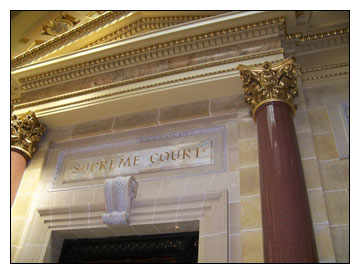Supreme Court shoots down open deliberations (UPDATE)
By: Jack Zemlicka, [email protected]//September 15, 2011//
Supreme Court shoots down open deliberations (UPDATE)
By: Jack Zemlicka, [email protected]//September 15, 2011//

The Wisconsin Supreme Court shot down proposals to hold private deliberations in public, but is still considering a therapeutic resolution to internal bickering that has plagued the court.
On Thursday, the justices voted against a trio of options to increase transparency proposed by Chief Justice Shirley Abrahamson. The proposal included holding discussions of cases and petitions for review in open conference.
Also on Thursday, the court tabled discussion on a plan to bring in outside help to improve group dynamics among the seven justices.
“I think we would benefit from an expert in conflict management technique,” said Justice Ann Walsh Bradley. “I favor this.”
Bradley and Justice David Prosser were involved in an altercation in June when she alleged that her colleague choked her during deliberations on a challenge to Gov. Scott Walker’s collective bargaining bill.
Though none of the justices cited the incident during their open conference, Bradley, along with Abrahamson, were the primary supporters of change in the way the court functions both in public and behind closed doors.
“Most of the time, we do very well,” Abrahamson said. “But there are these incidents than I am concerned about and you should be concerned.”
The court struggled to get through three hours of discussion Thursday morning without incident.
Justice Michael Gableman and Abrahamson disagreed about allowing John Voelker, director of State Courts, to offer testimony on the proposals during the conference.
After being called to the conference table by Gableman, Voelker was waved off by Abrahamson who said procedure does not allow for outside input during a conference.
Gableman was eventually allowed to ask Voelker to research if the court has ever engaged in conflict resolution training in the past. The findings will be presented to the court on Sept. 28.
Ethics attorney Dan Shneidman said the court would benefit from group therapy better than simply opening up internal case evaluations to the public.
“The undercurrent of the bitching and how does one Supreme Court Justice put their hands on the throat of another is ridiculous,” he said. “There are seven human beings on the court and there are obviously problems.”
Abrahamson recommended that the justices consider professional training in conflict resolution, either personally or in a small group setting, as a way to identify how the court can work in a more constructive manner.
As proposed, the cost of the sessions would be paid for by the justices.
“It might cost us a few bucks,” Abrahamson said. “But it can’t hurt. I feel this proposal is non-controversial.”
Justice Annette Ziegler called on Abrahamson to do a better job of promoting the positive interactions among the justices.
“When the door closes, the sky doesn’t fall,” Ziegler said. “I feel like we’re sending a message that there is a lot wrong and almost nothing right. Then we are drawn back into a black hole of we need an expert to come in.”
Ziegler was among the majority of justices who said that the written opinions by the court should be a primary voice of impartiality and neutrality.
She and others said that the best way to restore public confidence in the court is for it to simply do its job.
“This isn’t a comfort level issue for me,” Ziegler said. “It’s an institutional issue, and what is best for the court.”
Legal News
- State Bar leaders remain deeply divided over special purpose trust
- Former Wisconsin college chancellor fired over porn career is fighting to keep his faculty post
- Pecker says he pledged to be Trump campaign’s ‘eyes and ears’ during 2016 race
- A conservative quest to limit diversity programs gains momentum in states
- Wisconsin prison inmate pleads not guilty to killing cellmate
- Waukesha man sentenced to 30 years for Sex Trafficking
- 12-year-old shot in Milwaukee Wednesday with ‘serious injuries’
- Milwaukee man convicted of laundering proceeds of business email compromise fraud schemes
- Giuliani, Meadows among 18 indicted in Arizona fake electors case
- Some State Bar diversity participants walk away from program
- Wisconsin court issues arrest warrant ‘in error’ for Minocqua Brewing owner
- Iranian nationals charged cyber campaign targeting U.S. Companies
WLJ People
- Power 30 Personal Injury Attorneys – Russell Nicolet
- Power 30 Personal Injury Attorneys – Benjamin Nicolet
- Power 30 Personal Injury Attorneys – Dustin T. Woehl
- Power 30 Personal Injury Attorneys – Katherine Metzger
- Power 30 Personal Injury Attorneys – Joseph Ryan
- Power 30 Personal Injury Attorneys – James M. Ryan
- Power 30 Personal Injury Attorneys – Dana Wachs
- Power 30 Personal Injury Attorneys – Mark L. Thomsen
- Power 30 Personal Injury Attorneys – Matthew Lein
- Power 30 Personal Injury Attorneys – Jeffrey A. Pitman
- Power 30 Personal Injury Attorneys – William Pemberton
- Power 30 Personal Injury Attorneys – Howard S. Sicula











